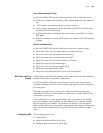
132 CHAPTER 5: IP ROUTING PROTOCOL OPERATION
For detailed information on the route reflector, see “Configuring a BGP Route
Reflector” on page 140.
Configuring Transmission of a Default Route to a Peer Group .
By default, a local router does not send a default route to any peer group.
However, if you use the peer default-route-advertise command, the local router
sends a default route, with itself as the next hop, to the peer even if there is no
default route in BGP routing table.
Configuring the BGP Router as the Next Hop in a Route
A BGP router can specify itself as the next hop while advertising a route to a peer
group.
By default, local router does not specify itself as the next hop while advertising
route to a peer group.
Removing Private AS Numbers When Transmitting BGP Update
Messages
Generally, the AS numbers (public AS numbers or private AS numbers) are
included in the AS paths while transmitting BGP update messages. This command
is used to configure a local router not to transmit private AS numbers when
transmitting update messages.
By default, the private AS numbers are included when transmitting BGP update
messages.
Table 100 Configuring Transmission of a Default Route to a Peer Group
Operation Command
Configure transmission of a default route to a
peer group
peer group-name default-route-advertise
Configure no transmission of a default route
to a peer group
undo peer group-name
default-route-advertise
Table 101 Configuring the Advertiser as the Next Hop in a Route
Operation Command
Configure itself as the next hop in advertising
route
peer group-name next-hop-local
Disable the specification of itself as the next
hop in advertising route
undo peer group-name next-hop-local
Table 102 Removing Private AS Numbers While Transmitting BGP Update Messages
Operation Command
Remove private AS numbers while
transmitting BGP update messages
peer group-name public-as-only
Include private AS numbers while transmitting
BGP update messages
undo peer group-name public-as-only


















